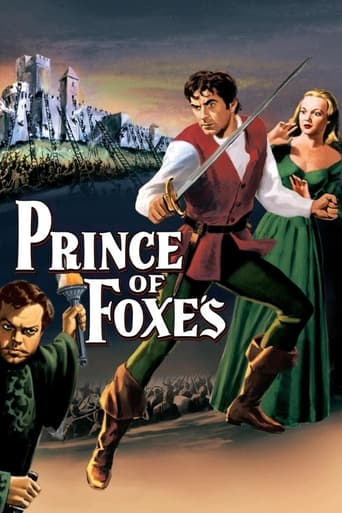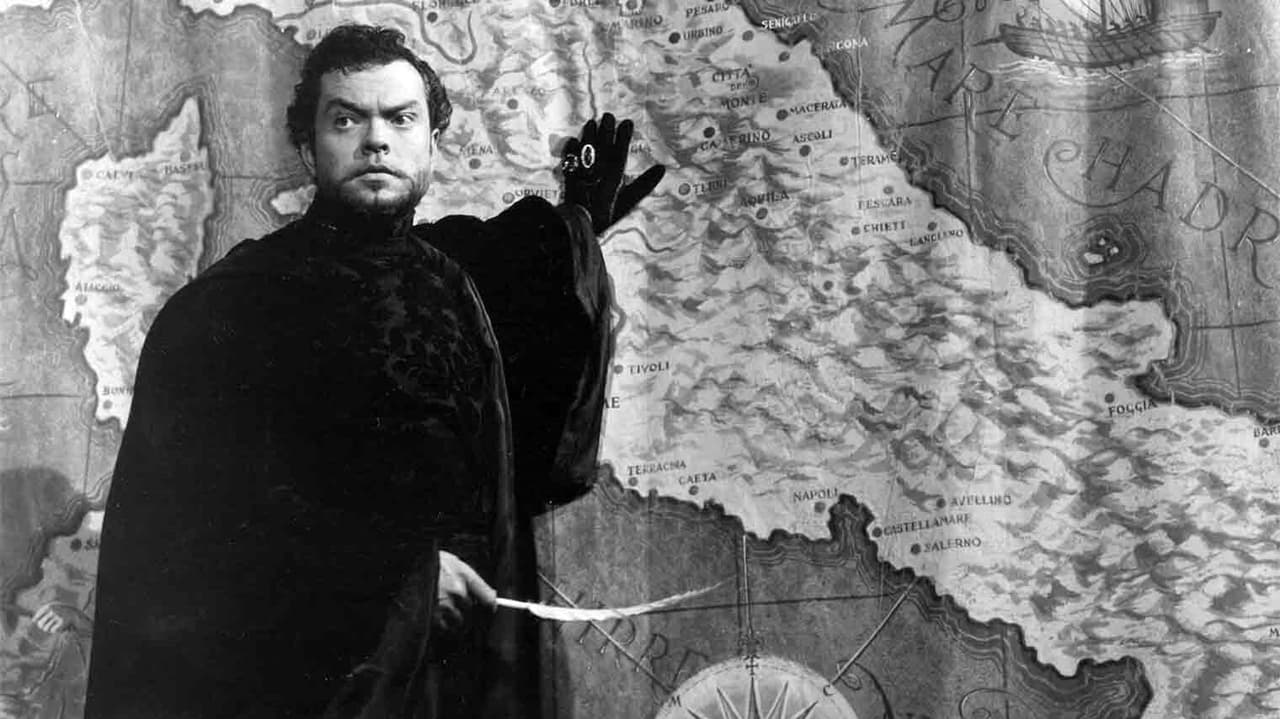deickos
This was the film by Henry King I least liked - the production is alright but nothing really happens for me until... The supposed blinding scene and the (not so) supposed happy ending. Let me explain myself and hopefully Henry King - this grand master: there are two different versions and two different endings provided simultaneously! This is only done in Shakespeare - As you like it. One for the audience and one for the few.
ilprofessore-1
One of the first grand scale Hollywood historical melodramas shot entirely on location throughout Italy and at Cinecitta in 1948-9 only a few years after the Second World War, this film benefits from its believable historical settings. Superbly composed and photographed in B&W by one of Zanuck's best cinematographers, Leon Shamroy, and costumed lavishly by the great Vittorio Nino Novarese, the visual aspects of this film add an unusual authenticity to the story. In addition, we have some grand theatrical acting from such classic scene-stealers as the great Katina Paxinao from Greece, England's Felix Alymer (Polonius to Olivier's Hamlet) and America's own wunderkind Orson Welles reunited with his Bernstein from Citizen Kane, Everett Sloane. (Watching Sloane's performance in this film one can only regret that he did not play Iago to Orson's Othello.) The beautiful but rather wooden Wanda Hendrix as Camilla Verana can't compete in this superb ensemble, all directed masterfully by the underestimated Henry King, but the overall effect is magnificent. Who said you can't make a silk purse out of a sow's ear. Not if the sow is Italian!
funkyfry
I was very pleased with pretty much every aspect of this production. This is really an exceptional historical drama, and although it doesn't have some of the pure thrills of the best swashbuckling action films it more than makes up for it in my book with a complex, adult story that takes the main characters through major transformations. There are many twists and turns in the narrative but all are handled in such a way that neither suspense nor character are sacrificed.The film tells the story of Orsini (Tyrone Power), or a man who calls himself Orsini (we find out that his true mother was a peasant), an extremely cynical and ambitious man in the employ of the famous warlord Cesare Borgia (Orson Welles). Borgia sends him on several missions during which the stated goal is for Orsini to arrange and break marriages that will prove advantageous to Borgia. When he arrives for his first mission in Vienna, he is immediately the object of a botched assassination attempt, but instead of killing the assassin Mario Belli (Everett Sloane) he makes him his assistant. This might seem arbitrary but the further we get into the film we see this is Orsini's true character; he is a master at taking the negative things life throws him and turning them positive.Sloane does his best to steal every scene that Welles hasn't already absconded with, but Power manages to focus the attention on himself a surprising amount of the time all things considered. All 3 are powerful and interesting characters, with Welles' Borgia unfortunately missing in action for the main part of the action but reappearing in a startling torture/dinner scene towards the climax (this is also Sloane's best scene in the film). Those expecting a straightforward adventure/romance story like "Scarlet Pimpernell" or "Zorro" best look elsewhere this is a story of corruption, betrayal, and redemption which engages the question of the ultimate value or worth of an individual's life. The film's creators have set themselves up with a difficult task they need to make us dislike Orsini just enough to believe that he truly is a complete opportunist with a consciously Machiavellian philosophy, but like him enough to believe that he's undergoing a slow moral transformation under the influence of Count Verano (Felix Aylmer) and his young wife "Madonna"/Camilla (Wanda Hendrix). They succeed almost perfectly, hampered only slightly by Hendrix' lack of presence (a definite necessity for this role which combines sexual and religious overtones with her royal station). At one point there's a biblical analogy going on, as Orsini paints his friend Belli in a "last supper" scene as Judas and seems to paint Camilla as the Lady Madonna. So there's just a lot going on here depending on where your gaze wanders. In the early parts of the film when Orsini is a total cynic about morality who took advantage of everyone else, I thought I was looking at a kind of period film noir in fact his character in the beginning is very similar to his great performance in "Nightmare Alley." His dramatic character development is handled in a relatively subtle way there's a kernel of good in his soul that's revealed in his painting, a reflection of his ability to see beauty in people that's been buried by the harsh demands of life. It does make sense that eventually he would see the beauty and good in himself as well.There seems to be some controversy on the subject of the photography of the film, which many posters say should have been done in color. In my opinion the film has much more style and beauty in black and white. Technicolor is better suited to a less dramatic story; even though this film has some great spectacle including a full-blown castle siege and a memorable woodland battle in the mist I think the photography was excellent, and the black and white enhanced the details and beauty of the interiors while keeping the focus firmly set on the actors. Night-time scenes like Belli's assassination attempt and the eerie misty forest would not be as effective in color either. As soon as I saw that this was a serious dramatic piece I was glad not to be distracted by anyone's purple and green tights.One last note on Alfred Newman's score it is remarkable, one of the best for an epic/period film that I've ever heard. Combined with excellent photography, indelible performances from the 3 male leads, seemingly dozens of authentic Italian locations, and a mature intelligent screenplay, it provides director Henry King with the best production that I've yet seen from the veteran director. I've never known King as a particularly good director of actors but in this film we have 3 performances that are unforgettable. Welles with his bizarre beard and brazen manner paint a portrait of unworthy ambition at first his greed and power appear glamorous and appealing to us just as they do to Orsini, but eventually he is shown as a petty malicious fool when Orsini and Belli trick him in the supper scene. Sloane's Belli is a fascinating character, totally unpredictable in his behavior but somehow still believable as a human being. Power's Orsini is a remarkable character as well, revealing depths of feeling in the heart of a true warrior. This is just the type of film that entertains you immensely with its plot twists and character developments on first viewing but which I suspect will reveal even more depth upon multiple viewings.
dbdumonteil
Henry King was the prince of a genre which has completely disappeared today:storybook adventures,with never a dull moment;"Lloyds of London" "captain of Castillo" ,"Untamed" or "the bravados" ,to name but four were absorbing flicks.He wanted to film "Price of foxes" in color:it's unfortunate that he did not get his wish cause the lavish settings ,the beautiful landscapes (filmed on location in Italy) and the painstaking reconstruction deserved that.Of course ,Orson Welles steals every scene he's in,the best Cesar Borgia one ever saw on a screen.But the rest of the cast is excellent as well,particularly Katrina Paxinou,as Andrea's peasant mother.Tyrone Power was perfectly cast in the swashbuckler genre.Roughly,the film consists of three parts -Orsini helps Borgia with his problem:marrying his sister Lucrecia with Alfonso D'Este,in order to enter into an alliance with the dukedom of Ferrare.-Orsini must help Borgia with another problem :doing away with an old lord -who is married to a gorgeous young girl who "could be his granddaughter"Borgia dixit.-Having betrayed the Master , he will have to accept the consequences.Biggest flaw: the "enucleation":how can a man as smart as Borgia be fooled like a child?



 AD
AD



